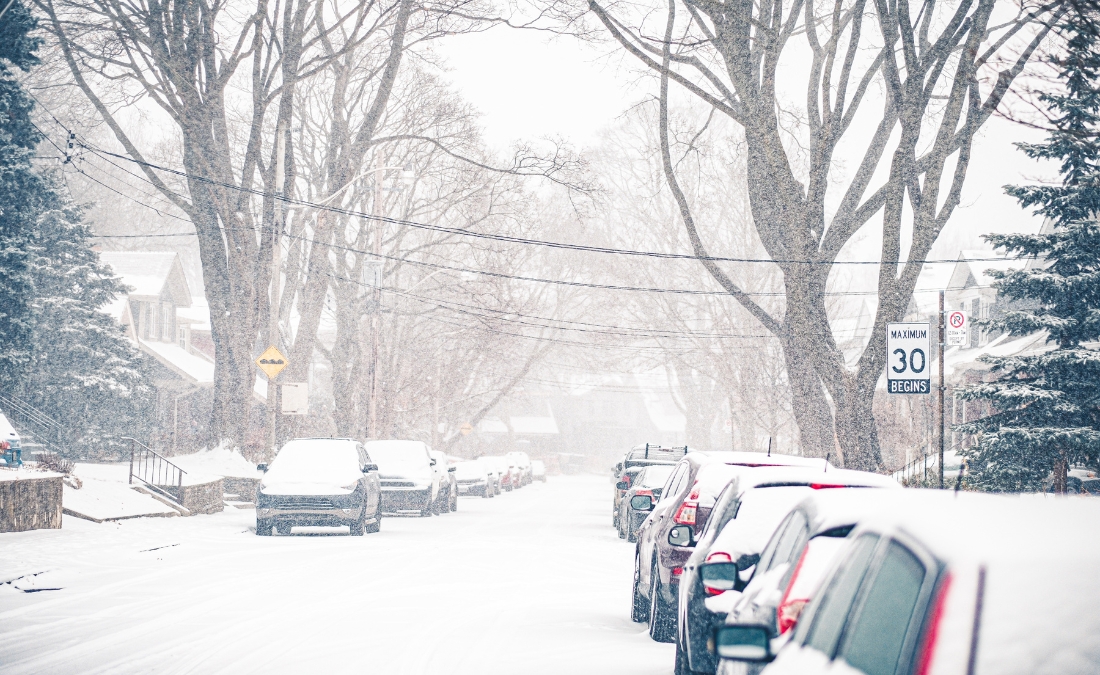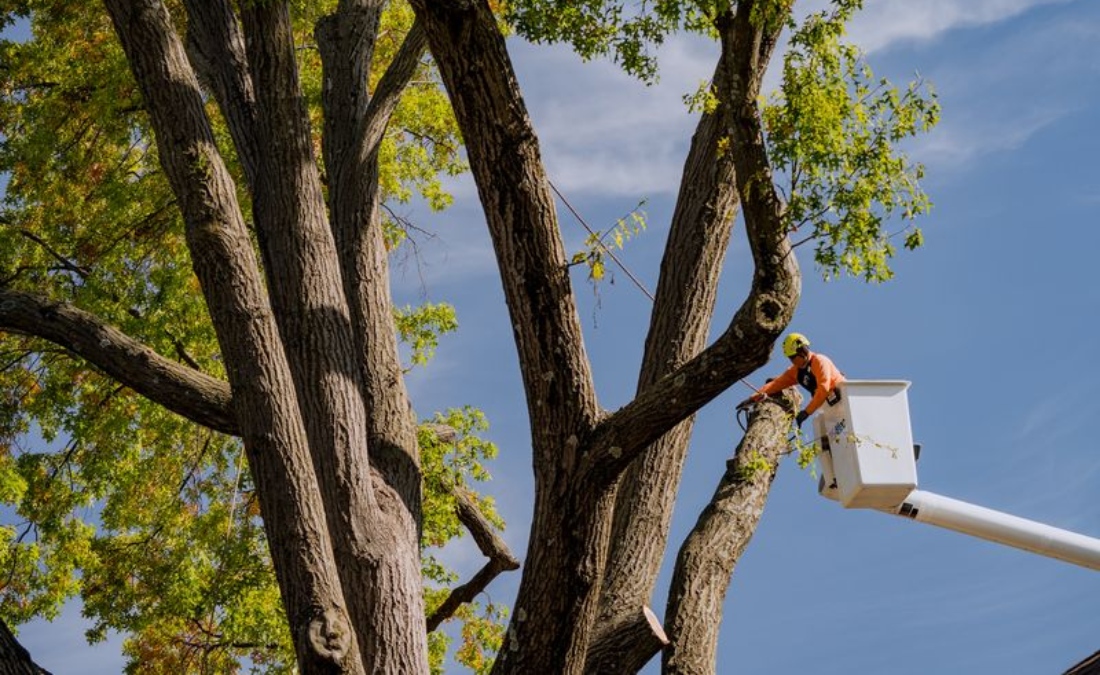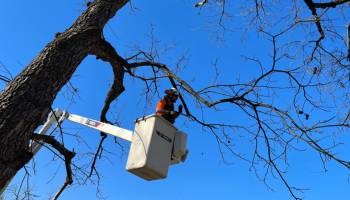Maple Trees: A Complete Guide to Planting & Care

Maple trees are a popular tree species known for the characteristic leaf shape and vibrant fall colors.
Maple trees are a popular tree species known for the characteristic leaf shape and vibrant fall colors. Whether you’re looking to add beauty or utility to your landscape, maple trees offer a variety of benefits. But tree care is an important part of keeping these majestic trees healthy. Let’s explore the basics of tree health care for maple trees!

Guide to Maple Trees
What Does a Maple Tree Look Like?
Maple tree bark is usually grayish brown in color, with shallow ridges or furrows. In springtime, maple trees produce showy flowers that range in color from yellow to red, depending on the variety of maple tree. As fall approaches, maple trees put on a stunning display as they turn shades of red, yellow and orange before shedding their leaves for winter. The maple trees’ distinctive seed pods – called samaras – are also fascinating to observe as they spiral to the ground in the breeze.
Whether planted in a residential landscape or natural setting, maple trees are an attractive addition to any outdoor space. With their vibrant colors and interesting seed pods, maple trees have become a popular choice among gardeners looking to add beauty to their landscape. Not only do they bring visual interest, but also maple trees are also hearty and long-lived, making them a great choice for those who want to enjoy their greenery for years to come.
How Fast Do Maple Trees Grow?
Maple trees are fast-growing, with some maple tree varieties growing at a rate of between 1 and 2 feet per year. As they mature, maple trees typically start to grow more slowly, with growth rates slowing down in their later stages of life. Maple species that are known for their rapid growth include red maple (Acer rubrum), Sugar Maple (Acer Saccharum) and Silver Maple (Acer saccharinum).
How Big do Maple Trees Get?
The size of maple trees can vary greatly depending on the maple species and environmental conditions. Generally, maple trees can reach heights up to 50 feet tall with a spread up to 35 feet wide. As maple trees mature, their root system extends outward, creating an even larger presence in the landscape.
How Long do Maple Trees Live?
The maple tree is a species that can live for centuries; some maple trees have been known to reach ages of more than 300 years. However, the average lifespan of maple trees varies depending on types and conditions. Generally, most maple trees will live around 80-120 years if they are grown in optimal conditions with plenty of sunlight, water and nutrients. When maple trees experience extreme weather conditions or poor soil quality, their longevity may be shortened significantly. In addition, maple tree diseases and pests can also cause maple trees to suffer from premature death. By providing a healthy growing environment for maple trees, homeowners and gardeners can help ensure these majestic plants remain strong for generations to come.
How Many Species of Maple Trees are there?
The maple tree family is quite expansive, with more than 125 different species of maple trees ranging in size and shape. Some of the most recognizable maple tree species include red maple, silver maple, Norway maple, sugar maple, box elder maple, and Japanese maple. Each species has its own unique characteristics such as bark texture and branching patterns. Additionally, each species can vary in terms of their ultimate height and width when mature. With so much variety within the maple tree family, it’s easy to see why these majestic trees have become a beloved part of our environment!
Some of the varieties of maples you might see include sugar maples, red maples or silver maples.
Sugar maples are a species of maple tree native to the Eastern United States and Canada. These majestic trees reach heights of up to 80 feet with branches that spread out in all directions, providing wonderful shade in summer months. The leaves of these trees have five distinct lobes and turn a vibrant yellow or orange during autumn, making them popular features in gardens. The sap of these trees is used to create the delicious and popular maple syrup we know and love. In early spring, when temperatures rise above freezing during the day but drop below at night, the sap begins to flow through a network of tubes known as ‘sugar bush’, which can then be collected by drilling small holes into the trunks of these trees. This sap can then be boiled down to create the delicious syrup, a process that requires great patience and skill. It is often said that one tree will produce up to 10 liters of syrup over its lifetime – now that’s something worth celebrating! Sugar maples are also well known for their wood, which is highly prized for its beautiful grain, coloring and durability. It is commonly used to make furniture, flooring and musical instruments such as drum shells and violins. The wood is also used to manufacture paper products such as high-end stationery or business cards – a fitting way to use this wonderful resource!
Silver maples, also known as soft maple, are a type of deciduous tree native to North America. They are typically found in eastern parts of the United States and Canada, growing up to heights of 80 feet. Silver maple trees have five-lobed leaves that are light green on top and silvery white underneath. They are often sold as ornamental trees due to their showy foliage and ease of pruning. The wood from silver maples is strong, light-colored and easy to work with. It can be used for a variety of projects such as furniture, cabinetry and flooring. Silver maple is also known for its fast growth rate, making it a great choice for windbreaks, shade and privacy screens. It can also be used as a street tree to provide shade in urban areas.
Red maples are one of the most widely distributed deciduous trees in North America. They typically grow to heights of up to 50 feet and have a relatively shallow root system. The leaves are usually five-lobed, dark green in summer, changing to yellow, orange or red in autumn — hence their common name. Red maple trees typically have clusters of small, bright red flowers that appear in the spring. The fruits are small, samara-like seeds with wings, which ripen in autumn and are dispersed by wind. The wood from red maples is used for furniture, flooring, paneling and other projects. It’s known for its strength and durability, as well as its light and pleasing grain patterns. Red maple is also a popular choice for landscaping, providing vibrant foliage and color in the fall months. It’s deciduous nature also makes it easy to prune and shape, making it an excellent addition to gardens or yards. The tree provides excellent shade in summer and can be used as a windbreak or privacy screen as well. Red maples are also relatively resistant to pests and disease, making them a great choice for planting in urban areas.
All in all, red maples are an excellent choice for those looking to add shade, color and texture to their outdoor space. With its vibrant foliage and strong wood, it

Where do Maple Trees Grow?
The great thing about maple trees is that they’re not too picky when it comes to their environment. Maple trees are found in many areas all over the world, including North America and parts of Europe and Asia. They can handle different soil types and climates, making them a versatile species for landscapers to consider. As maple trees mature, their root systems become extensive which helps keep them well-anchored during stormy weather conditions. This makes maple trees an ideal choice in windy or wetter climates where other plants may blow away or struggle with standing water.

Source: Wikipedia
Is Maple Good Firewood?
Maple trees make a great choice for firewood due to its natural combustibility. Maple has a medium-high BTU rating and burns relatively hot, making it an excellent choice to heat your home or stovetop. It’s also easy to split and stack, so it’s convenient to store. However, maple does tend to produce more sparks than other hardwoods when burned, so you’ll want to take extra care if you’re burning maple near flammable items like furniture or curtains. All in all, maple is a great choice for your firewood needs!
Guide to Maple Tree Care
How to Plant a Maple Tree
Firstly, maple trees prefer acidic well-drained soils with a pH of 5.5 or lower. If your soil is too alkaline, you can always use peat moss or compost to bring down the pH level.
Secondly, maple tree roots need room to spread out so it’s best not to plant them too close together – try planting at least 8 feet away from other trees and shrubs.
When planting maple trees, dig a hole that’s twice as wide as the root ball and just as deep. Remove the maple tree from its container or burlap wrap, then place the maple tree in the hole so that it is sitting slightly higher than the surrounding soil. Place the maple tree’s roots in an outward direction, not downward.
After planting, use your hands to firmly press down on the soil around the maple tree so that it makes good contact with the roots. Then firm up any air pockets by compacting additional soil over top of them. Finally, water thoroughly for at least a few minutes until you can see that all of the soil has been moistened completely.
Once maple trees are planted properly and given adequate care throughout their lives, they will thrive and produce beautiful foliage each year. With maple trees, you’ll be able to enjoy the natural beauty and shade they offer for many years to come!
How to Care for a Maple Tree
Caring for a maple tree involves regular pruning, mulching and watering. Prune the tree to remove dead or damaged branches as well as any excess foliage. Mulch around the tree base to prevent weeds and retain moisture. Water regularly during dry periods but avoid overwatering.
- Watering: Maple trees need regular irrigation when the soil is dry for best growth results. It’s important to note that overwatering can cause root rot, so be sure not to overdo it. To help ensure the maple tree’s long-term health, it is important to water them regularly (about once a week, depending on your local climate) during the first growing season.
- Fertilizing: Fertilizing your maple tree will help encourage new growth and provide vital nutrients for healthy tree growth. It’s best to fertilize in the fall or early spring before buds develop, as this allows for maximum absorption of nutrients.
- Soil and Sun: All varieties of maple prefer well-drained, acidic and moist soil.
- Monitoring pests and diseases: This is an important step in tree health care that often gets overlooked. Regularly check your tree for signs of pests or diseases such as aphids, cankers, discoloration, wilting, rotting bark or leaf spot diseases so you can address any potential issues quickly.
How and When to Prune Maple Trees
The best time to prune maple trees is in the late winter or early spring months, when they are dormant and not producing new growth. Pruning maple trees can help remove dead or diseased limbs and encourage healthy new growth. It also helps open up the canopy so that sunlight can reach all areas of the tree.
When it comes to actually pruning your maple tree, there are a few things you should keep in mind. Start by inspecting the tree for dead, diseased, or broken limbs and removing them with proper pruning tools. Next, start trimming branches that are too close together or crossing over each other. You should also remove any weak growth so that the maple tree can focus its energy on healthy new growth. Finally, when you’re done pruning maple trees, be sure to clean up any debris and dispose of it properly.
PRO TIP: Want to learn more about some of the common species in the Midwest and Great Plains? See our previous articles on other species:

Guide to Maple Tree Leaves
What Does a Maple Leaf Look Like?
The maple leaf is one of the most recognizable symbols of Canada, and it’s easy to see why! Maple leaves have a distinct shape that can be easily identified. They typically come in two or three lobes with jagged edges and points. The maple leaves are bright green in color during the summer months and turn an array of vibrant reds, oranges, and yellows during the autumn season. There is truly no better sight than maple trees covered with their colorful foliage at peak fall times. Whether you’re admiring them from afar or getting up close to really appreciate their details, maple leaves are always worth a look!
How to Draw a Maple Leaf
With its distinct shape and intricate veins, it makes a beautiful addition to your artwork or crafts. Here’s how you can draw a maple leaf:
Start by sketching out the outline of the maple leaf. Draw an oval shape with three bumps at the end. Next, draw two long lines outward from each side of the leaf for veins, curving them inwards as they reach the sides. You can add more detail by drawing small curved lines along these veins or shading lightly around them. Finally, if desired, add a few jagged edges to make the bottom edge of the maple leaf look more realistic.
Looking for a different way to draw a maple leaf? Check out the video below!
Guide to Maple Tree Seeds
What do Maple Seeds Look Like?
A maple tree’s seeds, or samaras, are distinct in their form and appearance. The maple seed hangs from a curved stem that looks like a tiny helicopter blade, helping the maple propagate across vast distances. Each maple seed has two wings, which can measure anywhere from 1 to 2 inches long, with each wing having four lobes that come together in the center. The lobes are typically dark brown or black in color but may have lighter patches or mottling depending on the species of maple tree. Inside each maple seed is a single nutlet which contains the embryo for future growth. All maple seeds must be stored in moist conditions until they germinate to ensure a viable maple tree.

How Are Maple Seeds Dispersed?
Maple trees use both wind and animals to disperse their seeds. A maple tree produces distinctive ‘helicopter’ shaped wings that spin as they fall, using the air currents to transport them away from the parent tree. These maple seed wings can be carried hundreds of meters away by strong winds, giving maple trees an advantage over other species in areas with high winds. Maple trees also rely on birds and small mammals such as squirrels for dispersal. Many animals are attracted to the maple’s sweet-tasting winged fruits, which provide a valuable source of nutrition when food is scarce during winter months. The maple’s nutritious seed can then travel far and wide attached to the fur or feathers of these creatures, allowing maple trees to spread across large areas.
Are Maple Seeds Edible?
Many wonder if maple seeds can be safely consumed. The answer is yes. Maple seeds, or ‘helicopters’ as they are known colloquially, are edible but they should be treated with care – their hard exterior may cause harm if ingested in large quantities. To ensure safety, maple seeds should not be eaten raw but rather toasted over an open flame before consumption. Doing so will lessen the risk and bring out the natural sweetness that maple seeds contain. Simply gather some maple helicopter seeds, toast them over a fire until lightly browned and enjoy! With proper preparation, maple helicopters make a great addition to your outdoor meals.
Guide to Maple Syrup
How to Make Maple Syrup
- Identify maple trees – maple syrup is best made from maple tree species such as sugar maple, black maple or red maple. Look for an area with lots of these trees that are between 25 and 75 years old.
- Tap the trees – drill a small hole into each tree you want to tap and insert a spout or ‘spile’ in the opening. This will collect the sap from each tree which can then be collected without damaging the tree.
- Collect the sap – place containers beneath each spile to collect the sap as it flows out of the tree, ideally before temperatures drop below freezing at night.
- Boil the sap – when you’ve collected enough sap, move it to a large pot or cauldron and boil until it thickens into syrup. Be sure to stir regularly and keep an eye on the temperature as boiling too quickly can cause it to caramelize.
- Filter the maple syrup – strain your maple syrup through cheesecloth (or other cloth filter) to remove any bark, maple leaf or twig fragments that may have gotten into the boiled syrup.
- Bottle the maple syrup – pour your filtered maple syrup into clean bottles or jars for storage and future use! Enjoy your homemade maple syrup!

Making maple syrup is a rewarding activity that requires patience and a little bit of know-how. With the right maple trees, some tapping equipment, and some boiling utensils, you can make your own maple syrup that is sure to please!
Is Maple Syrup Good for You?
The good news is that maple syrup can provide some benefits when consumed in moderation. Studies have shown that maple syrup contains beneficial antioxidants, which may help protect your body from harmful free radicals. It also contains trace amounts of minerals such as zinc, iron, calcium, and magnesium. Additionally, maple syrup has been found to contain compounds called polyphenols which are associated with reducing inflammation in the body. However, maple syrup does contain sugar so it should still be consumed in moderation for health benefits. If you’re looking to get the most out of maple syrup, try adding it to plain yogurt or oatmeal instead of using processed sugars like white sugar or high-fructose corn syrup. Enjoy maple syrup in moderation and bask in the sweet health benefits!
Does Maple Syrup Ever Go Bad?
Fortunately, maple syrup does not go bad like other syrups do. The high sugar content in maple syrup prevents the growth of bacteria or mold, meaning it can be stored for many years without any deterioration in flavor or quality. However, maple syrup should always be stored properly in an airtight container to prevent contamination or spoilage. If maple syrup is exposed to air over long periods of time, its quality will start to decrease and eventually it will become unusable.

Maple Trees are a versatile, useful and iconic plants that make any property come to life. Contact us today to get started on our custom comprehensive plant health care plan to keep your Maple trees happy and healthy.

Get the latest local news, tree care tips, special offers, and company updates directly to your inbox! It's easy to subscribe and there's no spam - we promise.
"*" indicates required fields





